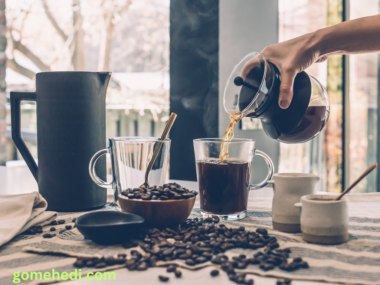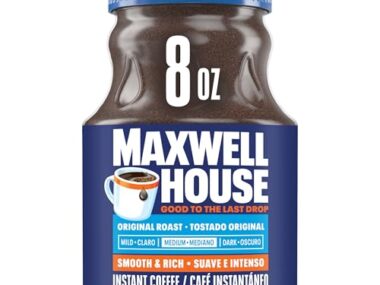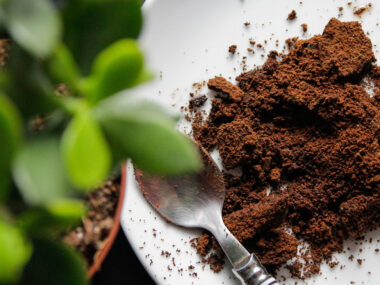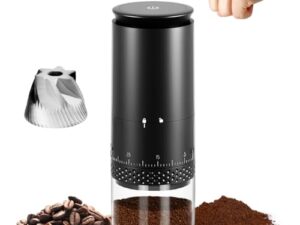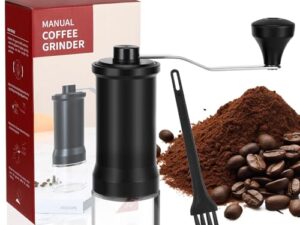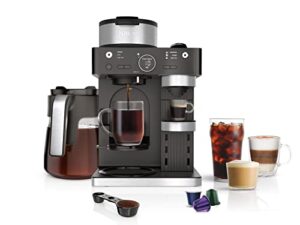Ground coffee is made from roasted coffee beans. These beans are ground into small particles.
Coffee lovers worldwide cherish ground coffee for its rich flavor and aroma. Ground coffee serves as the base for countless brewing methods, from espresso to drip coffee. Whether you buy pre-ground coffee or grind whole beans at home, the freshness of the grind greatly impacts the taste.
Understanding ground coffee can help you make better choices for your daily brew. In this post, we will explore what ground coffee is, its different types, and why it’s a favorite for many. Dive in to learn more about this essential coffee staple.
What Is Ground Coffee
Ground coffee is a popular choice for coffee lovers around the world. It is made by grinding roasted coffee beans. The size of the grind can affect the taste and strength of the coffee. But what exactly is ground coffee? Let’s explore this topic in detail.
What Is Ground Coffee?
Ground coffee is simply coffee beans that have been ground into smaller pieces. These ground beans are then brewed to make coffee. The size of the grind can vary from coarse to fine, depending on the brewing method used.
Types Of Ground Coffee
There are different types of ground coffee based on grind size. Here are a few common ones:
- Coarse Grind: Resembles sea salt. Ideal for French press and cold brew.
- Medium Grind: Similar to sand. Perfect for drip coffee makers.
- Fine Grind: Looks like sugar. Best for espresso machines.
How Is Ground Coffee Made?
The process of making ground coffee involves several steps:
- Roasting: Coffee beans are roasted to develop flavor.
- Grinding: The roasted beans are ground to the desired size.
- Packaging: The ground coffee is then packaged for sale.
Benefits Of Ground Coffee
Ground coffee offers several benefits:
- Convenient and quick to brew.
- Available in various grind sizes for different brewing methods.
- Easy to find in stores and online.
Storing Ground Coffee
Proper storage is key to maintaining the freshness of ground coffee. Here are some tips:
- Store in an airtight container.
- Keep in a cool, dark place.
- Avoid exposure to moisture and heat.
Popular Brands Of Ground Coffee
| Brand | Specialty |
|---|---|
| Starbucks | Wide variety of flavors. |
| Folgers | Affordable and accessible. |
| Lavazza | High-quality Italian coffee. |

Credit: kahwati.co.uk
Coffee Beans
Ground coffee is made from roasted coffee beans. These beans come from the coffee plant. After roasting, the beans are ground into small pieces. This process creates ground coffee. The quality of ground coffee depends on the coffee beans used.
Types Of Coffee Beans
There are four main types of coffee beans. Each type has its own unique flavor and aroma.
- Arabica: Arabica beans are the most popular. They have a sweet and soft taste. These beans are often used in high-quality coffee.
- Robusta: Robusta beans are strong and bitter. They have more caffeine than Arabica beans. These beans are often used in instant coffee and espresso.
- Liberica: Liberica beans have a unique flavor. They are fruity and floral. These beans are less common and often used in blends.
- Excelsa: Excelsa beans are rare. They have a tart and fruity flavor. These beans are often used to add complexity to coffee blends.
Here is a table comparing the main types of coffee beans:
| Type of Bean | Flavor | Caffeine Content | Common Uses |
|---|---|---|---|
| Arabica | Sweet and Soft | Low | High-Quality Coffee |
| Robusta | Strong and Bitter | High | Instant Coffee, Espresso |
| Liberica | Fruity and Floral | Medium | Blends |
| Excelsa | Tart and Fruity | Medium | Blends |
Processing Methods
Processing methods affect the flavor and quality of coffee. Here are the main methods:
- Dry Processing: Also known as natural processing. The whole coffee cherry dries in the sun. This method gives a fruity and full-bodied flavor.
- Wet Processing: Also known as washed processing. The cherry is removed from the beans before drying. This method gives a cleaner and brighter flavor.
- Honey Processing: A mix of dry and wet processing. The cherry is partially removed. This method gives a balanced flavor, with both sweetness and acidity.
- Giling Basah: A unique method used in Indonesia. The beans are hulled while still wet. This method gives a rich and earthy flavor.
Here is a table summarizing the main processing methods:
| Processing Method | Description | Flavor Profile |
|---|---|---|
| Dry Processing | Whole cherry dried in the sun | Fruity, Full-bodied |
| Wet Processing | Cherry removed before drying | Clean, Bright |
| Honey Processing | Partial removal of cherry | Balanced, Sweet and Acidic |
| Giling Basah | Wet hulling | Rich, Earthy |
Grinding Process
Ground coffee is coffee beans that have been milled into small particles. The grinding process is crucial to coffee preparation. It influences the flavor and strength of the coffee. Different grinding techniques and consistencies can result in a wide variety of tastes. Let’s explore these aspects in detail.
Grinding Techniques
Grinding coffee involves using tools or machines to break down coffee beans. The technique used can affect the taste and quality of the coffee. Here are some common grinding techniques:
- Blade Grinders: These are affordable and easy to use. They chop the beans with a spinning blade. This can result in uneven particle sizes.
- Burr Grinders: These use two revolving abrasive surfaces. They provide a more uniform grind. Burr grinders come in two types:
- Flat Burrs: Produce consistent particles. Ideal for espresso and drip coffee.
- Conical Burrs: Offer a wide range of grind sizes. Suitable for all brewing methods.
- Manual Grinders: These are hand-operated. They often use burrs. They are portable and good for small batches.
The choice of grinder can affect the brewing process. Consistency and control are key factors. Burr grinders are preferred for their precision. Blade grinders are suitable for a quick, budget-friendly option.
Grinding Consistency
Consistency in coffee grinding is vital. It ensures an even extraction of flavors. Different brewing methods require different grind sizes. Here is a simple table to illustrate:
| Brewing Method | Grind Size |
|---|---|
| Espresso | Fine |
| Drip Coffee | Medium |
| French Press | Coarse |
Fine grind particles are small and powdery. They are ideal for espresso. They allow for quick extraction under pressure. Medium grind is similar to sand. It works well with drip coffee makers. It allows water to flow at a moderate pace. Coarse grind resembles sea salt. It is perfect for French press. It allows for a longer steeping time without over-extraction.
Maintaining consistent grind size is essential. It ensures each coffee particle extracts at the same rate. This results in a balanced and flavorful cup. Inconsistent grind sizes can lead to uneven extraction. This can cause a mix of over-extracted and under-extracted flavors. Always aim for consistency to get the best results.
Flavor Profiles
Ground coffee is a daily staple for many around the world. Its rich flavor and invigorating aroma can elevate anyone’s morning. Understanding the flavor profiles of ground coffee can enhance your appreciation and enjoyment of this beloved beverage.
Aroma And Taste
The aroma and taste of ground coffee are two of its most defining characteristics. When you open a bag of freshly ground coffee, the scent that greets you is a blend of hundreds of volatile compounds. These compounds contribute to coffee’s distinctive smell and taste.
Aroma can range from fruity and floral to nutty and spicy. Each coffee variety has a unique scent profile. For example, Ethiopian coffee often has a fruity and floral aroma, while Brazilian coffee may have a more nutty and chocolatey scent.
Taste is just as varied. Coffee can taste sweet, bitter, sour, or savory. This complexity is due to the coffee beans’ origin, the roasting process, and the brewing method. Here are some common taste notes:
- Sweetness: Honey, caramel, or chocolate.
- Bitterness: Dark chocolate, nuts, or roasted flavors.
- Sourness: Citrus, berries, or green apple.
- Savory: Spices, herbs, or earthy tones.
Combining these aromas and tastes creates a multi-dimensional experience that makes each cup of coffee unique.
Factors Influencing Flavor
Several factors influence the flavor of ground coffee. Understanding these factors can help you choose the right coffee for your taste.
1. Coffee Bean Origin
The region where coffee is grown affects its flavor. Coffee from Africa often has fruity and floral notes. South American coffee tends to be nutty and chocolatey. Asian coffee can have earthy and spicy flavors.
2. Roast Level
The roasting process plays a crucial role in developing flavor. Light roasts preserve more of the beans’ natural flavors. Medium roasts balance acidity and body. Dark roasts highlight bold, roasted flavors.
3. Grind Size
The size of the coffee grind affects the extraction process. A finer grind produces a stronger flavor, while a coarser grind results in a milder taste. This is crucial for different brewing methods:
| Brewing Method | Grind Size |
|---|---|
| Espresso | Fine |
| Drip Coffee | Medium |
| French Press | Coarse |
4. Water Quality
The quality of water used in brewing can alter the coffee’s taste. Water with high mineral content can enhance flavors, while poor-quality water can impart off-tastes.
By understanding these factors, you can better appreciate the complexities of your ground coffee and enjoy a perfect cup every time.
Brewing Methods
Ground coffee is a staple for many coffee lovers. The method you use to brew it can greatly affect the flavor and quality of your cup. Understanding different brewing methods can help you make the best cup of coffee possible.
Popular Brewing Techniques
There are many ways to brew ground coffee. Each method brings out different flavors and aromas. Here are some popular techniques:
- Drip Coffee: This is one of the most common methods. It involves pouring hot water over coffee grounds in a filter. The water then drips through into a carafe or pot. It’s easy and convenient.
- French Press: This method involves steeping coarse coffee grounds in hot water. After a few minutes, you press a plunger down to separate the grounds from the liquid. It produces a rich and full-bodied coffee.
- Espresso: This is a favorite for those who like strong coffee. It uses finely ground coffee and forces hot water through it at high pressure. The result is a small but intense shot of coffee.
- Pour Over: This method involves pouring hot water over coffee grounds in a filter, similar to drip coffee. But you control the water flow, which can enhance the flavor. It’s a bit more hands-on but worth it for coffee enthusiasts.
- AeroPress: This is a newer method that uses air pressure to push water through coffee grounds. It’s quick and easy, and it makes a smooth, rich cup of coffee.
Choosing The Right Grind
The grind size of your coffee beans is crucial. It can affect the taste and strength of your coffee. Here are some tips to help you choose the right grind:
| Brewing Method | Grind Size |
|---|---|
| Drip Coffee | Medium |
| French Press | Coarse |
| Espresso | Fine |
| Pour Over | Medium-Fine |
| AeroPress | Medium |
Using the correct grind size can make a big difference. A coarse grind for a French Press ensures the grounds don’t seep through the filter. A fine grind for an espresso machine allows for maximum flavor extraction. If the grind is too fine, it can make your coffee taste bitter. If it’s too coarse, your coffee might be weak and watery.
Experiment with different grind sizes to find what works best for you. Freshly ground coffee is always better. Using a burr grinder can help you get a consistent grind size, which is important for a great cup of coffee.
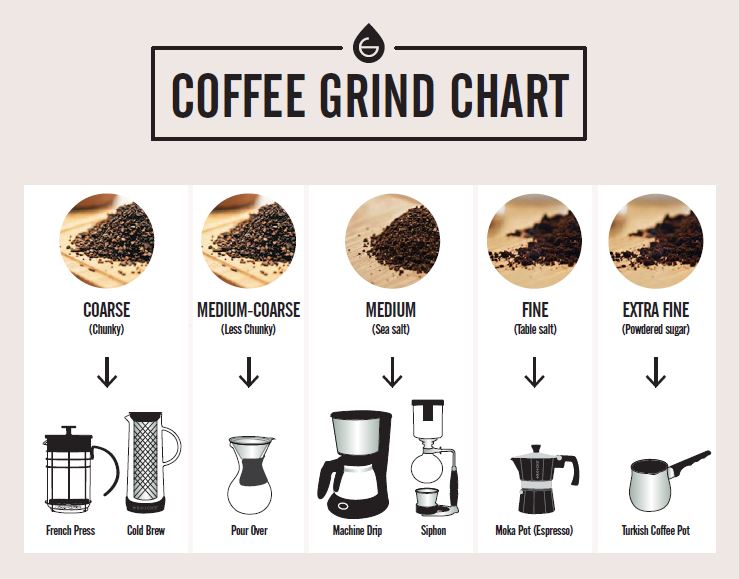
Credit: grosche.ca
Storage Tips
Ground coffee is a staple for many coffee lovers. But how you store it can make a big difference in its flavor and freshness. Proper storage can ensure that your ground coffee stays fresh and flavorful for as long as possible. Here are some essential storage tips to keep your coffee at its best.
Best Practices
Storing ground coffee properly is crucial to maintaining its flavor and aroma. Here are some best practices to follow:
- Airtight Containers: Use airtight containers to keep out air, moisture, and other contaminants. Glass, ceramic, or stainless steel containers with tight seals work best.
- Cool, Dark Place: Store your coffee in a cool, dark place, away from direct sunlight and heat sources. A pantry or cupboard is ideal.
- Avoid Fridge or Freezer: Storing coffee in the fridge or freezer can introduce moisture and odors that can affect its taste. It’s best to keep it at room temperature.
- Buy in Small Quantities: Purchase coffee in small amounts that you can use within a couple of weeks. This ensures you always have fresh coffee.
- Label with Date: Mark the container with the date of purchase or grinding. This helps you keep track of how long the coffee has been stored.
Avoiding Staleness
Stale coffee lacks the rich, full flavor that fresh coffee has. To avoid staleness, follow these tips:
- Avoid Air Exposure: Oxygen is the enemy of coffee freshness. Always keep your coffee in an airtight container.
- Minimize Light Exposure: Light can degrade the quality of coffee. Store your coffee in an opaque container or in a dark place.
- Protect from Heat: Heat accelerates the breakdown of coffee’s flavor compounds. Keep your coffee away from heat sources like stoves or ovens.
- Use a Proper Scoop: Use a clean, dry scoop every time you measure coffee. This prevents moisture and contaminants from getting into the container.
- Keep Away from Strong Odors: Coffee can absorb strong odors from its surroundings. Store it away from spices, cleaning products, and other strong-smelling items.
Following these tips will help ensure that your ground coffee stays as fresh and flavorful as possible. Happy brewing!
Health Benefits
Ground coffee is a popular way to enjoy the rich, full flavors of coffee beans. It is made by grinding roasted coffee beans into a fine or coarse powder. Besides its delightful taste and aroma, ground coffee offers several health benefits. Understanding these benefits can enhance your coffee-drinking experience.
Antioxidants In Coffee
Coffee is packed with antioxidants, which are compounds that fight free radicals in the body. Free radicals can damage cells and lead to various health issues. Drinking ground coffee can help reduce this damage.
Some key antioxidants found in coffee include:
- Chlorogenic Acid: This antioxidant helps lower blood pressure and improve heart health.
- Quinic Acid: Known for its detoxifying properties, it supports liver function.
- Cafestol and Kahweol: These compounds have anti-inflammatory effects.
Antioxidants can also boost your immune system. They help the body fight off infections and other illnesses. Coffee’s antioxidants can improve skin health too. They help to reduce the appearance of wrinkles and fine lines.
To illustrate the antioxidant content in coffee, here’s a simple table:
| Antioxidant | Health Benefit |
|---|---|
| Chlorogenic Acid | Lowers blood pressure |
| Quinic Acid | Detoxifies liver |
| Cafestol and Kahweol | Reduces inflammation |
Including ground coffee in your diet can be a tasty way to boost your antioxidant intake.
Moderation And Consumption
While ground coffee offers many benefits, it is important to consume it in moderation. Drinking too much coffee can lead to negative side effects like jitteriness, anxiety, and sleep issues.
Experts recommend limiting coffee intake to about 3-4 cups per day. This amount provides the benefits without the drawbacks. Here are some tips for moderate coffee consumption:
- Start your day with a cup: Enjoy a cup in the morning to boost energy.
- Avoid coffee late in the day: Drinking coffee in the evening can disrupt sleep.
- Choose quality over quantity: Opt for high-quality ground coffee for better flavor and health benefits.
Moderate coffee consumption can also support weight management. Coffee can enhance metabolism and aid in burning calories. It can also improve mental alertness and concentration.
Here is a summary of the recommended coffee intake:
| Time of Day | Recommended Cups |
|---|---|
| Morning | 1-2 cups |
| Afternoon | 1 cup |
| Evening | Avoid |
Balancing coffee consumption can help you enjoy its benefits while minimizing any negative effects.

Credit: www.wakacoffee.com
Sustainability Issues
Ground coffee is a popular choice for coffee lovers. It is made by grinding roasted coffee beans into fine particles. While enjoying a cup of ground coffee, it’s important to consider sustainability issues. These include how the coffee is sourced and its impact on the environment.
Ethical Sourcing
Ethical sourcing is crucial in the coffee industry. It ensures that coffee farmers are treated fairly and paid well. Many coffee farmers live in developing countries and depend on coffee for their livelihood. Ethical sourcing helps improve their quality of life.
When coffee is sourced ethically, it often follows standards like Fair Trade. These standards guarantee fair prices and better working conditions for farmers. Here are some benefits of ethical sourcing:
- Fair Wages: Farmers receive a fair price for their coffee.
- Safe Working Conditions: Workers have safe and healthy environments.
- Community Development: Part of the profits goes back to the community.
Ethical sourcing also involves transparency in the supply chain. This means knowing where the coffee comes from and how it is produced. This transparency helps consumers make informed choices. They can support brands that prioritize ethical practices.
Here is a table summarizing the key aspects of ethical sourcing:
| Aspect | Description |
|---|---|
| Fair Wages | Ensuring farmers get fair prices for their coffee. |
| Safe Working Conditions | Providing healthy and safe work environments. |
| Community Development | Investing in local communities through profits. |
| Supply Chain Transparency | Knowing the journey of coffee from farm to cup. |
Environmental Impact
The environmental impact of coffee production is significant. Coffee farming can lead to deforestation, water pollution, and soil degradation. Sustainable farming practices can help reduce these impacts.
Sustainable coffee farming involves methods that protect the environment. These methods include:
- Shade-Grown Coffee: Growing coffee under a canopy of trees. This helps preserve forests and supports biodiversity.
- Organic Farming: Avoiding chemical pesticides and fertilizers. Using natural methods to grow coffee.
- Water Conservation: Implementing practices to reduce water usage. This includes efficient irrigation systems.
Another aspect is the carbon footprint of coffee production. Transporting coffee beans across the globe contributes to greenhouse gas emissions. Supporting local coffee roasters can help reduce this footprint.
Here is a table showing the benefits of sustainable farming practices:
| Practice | Benefit |
|---|---|
| Shade-Grown Coffee | Preserves forests and supports wildlife. |
| Organic Farming | Protects soil and water from chemicals. |
| Water Conservation | Reduces water usage and protects local water sources. |
Choosing coffee brands that prioritize sustainability is key. It helps protect the environment and supports ethical practices in the coffee industry.
Frequently Asked Questions
What Is Ground Coffee?
Ground coffee is coffee beans that have been ground into small particles. It’s used for brewing coffee.
How Is Ground Coffee Made?
Ground coffee is made by grinding roasted coffee beans. The grind size varies depending on the brewing method.
What Are The Types Of Ground Coffee?
Types of ground coffee include coarse, medium, and fine grinds. Each suits different brewing methods.
How Should Ground Coffee Be Stored?
Store ground coffee in an airtight container. Keep it in a cool, dark place to maintain freshness.
Conclusion
Ground coffee offers a rich and flavorful experience. It’s essential for many coffee lovers. Choosing the right grind size impacts the taste. Freshly ground beans provide the best aroma and flavor. Remember to store your ground coffee properly. This keeps it fresh and delicious for longer.
Experiment with different beans and grind sizes. Find what suits your taste best. Enjoy the journey of discovering new coffee experiences. Happy brewing!
